Can chemicals really help to roll back the years? Victoria Gill investigates the various treatments that come with the promise of youth
Can chemicals really help to roll back the years? Victoria Gill investigates the various treatments that come with the promise of youth
The queues began to form outside Boots stores throughout the UK as early as 5 am on 4 May. The high-street pharmacist, already prepared for the rush, opened its doors early for the first time in its history to cope with the crowds. The determined shoppers were all there for just one thing - a cure for the inescapable curse of old age. They wanted to buy an anti-wrinkle cream.
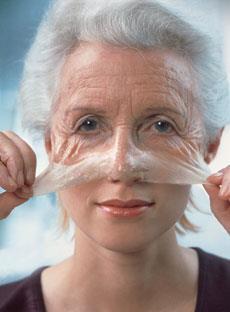
These people (mostly women) were persuaded out of their beds by a report from researchers at the University of Manchester, UK, showing that the cream was actually effective in reducing the appearance of wrinkles. (It has since emerged that Boots paid for the experiments that were the basis for this claim, although both the company and the research team maintain that the results were genuine.) Yet the cream’s active ingredient, pro-retinol, is neither new, nor exclusive to this one product, appearing in many skin creams making similar promises.
And while these products are often dismissed as superficial or even ineffective, the market for anti-ageing products continues to flourish. Many manufacturers claim that their modern formulations are now far more than mere cosmetics. So what is the science behind the celebrity-endorsed hype?
Are vitamins good for your skin?
The ingredient that so excited those shoppers, pro-retinol, is actually an umbrella term for a variety of precursor compounds of retinol, the endogenous form of vitamin A, which is vital for proper growth and development. Vitamin A maintains the epithelial lining of tissues, including mucous membranes and skin, and deficiency can lead to degenerative disorders of the eye, skin and, in the longer term, bones.
As early as the 1930s, the idea emerged that vitamin A derivatives, retinoids, could treat skin disorders. The anti-ageing properties of this class of compound were confirmed by Albert Kligman from the University of Pennsylvania, Philadelphia, US, in 1982. While investigating the use of topical retinoic acid for facial acne, Kligman noticed that his patients’ wrinkles were improving.1 A group led by John Voorhees from the University of Michigan, Ann Arbor, US, subsequently showed that retinoic acid works by stimulating fibroblast cells in the dermis (see image, p56) to produce a key component of youthful skin: collagen.
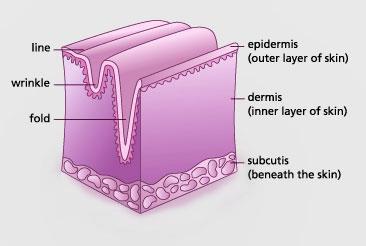
Collagen is a long, fibrous protein and a major constituent of connective tissue. Tough collagen fibres, formed from bundles of collagen, provide structural support for most tissues. In the dermal layer of skin, collagen and another protein, elastin, make up a strong, flexible matrix. As skin ages, fibroblasts produce less collagen and skin gradually loses this support and elasticity, causing the deep wrinkles and sagging that are the familiar physical signs of old age. Persuading ageing cells to produce more collagen can make skin more supple, allowing it to bounce back after being scrunched into a scowl or stretched into a grin.
Helen Knaggs is vice president of global R&D at NuSkin, a skincare company based in Provo, Utah, US, which specialises in anti-ageing treatments. She describes the discovery that simply rubbing retinoic acid onto skin can stimulate collagen production as a landmark. ’This provided some of the first clinical proof of an effective active ingredient,’ she says. So, if there is proof that this works, why is it not added to all anti-wrinkle creams?
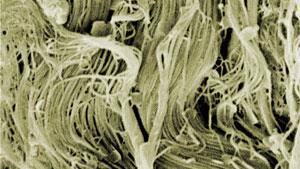
As Knaggs explains, there are strict regulatory limits imposed on these products. Creams containing retinoic acid are only available on prescription in the US, for treating sun damage and acne. ’Precursors and chemically similar compounds, such as pro-retinol and retinaldehyde, are used in a number of cosmetics. These are regarded as safe by the US Food and Drug Administration (FDA) so they make a suitable alternative.’
Some ’actives’, such as alpha-hydroxy acids extracted from fruit, simply rely on their acidity to break down dead skin cells and reveal the ’newer’ skin underneath. These pose less of a regulatory challenge, but they may also have contributed to some of the negative feeling about anti-wrinkle creams. ’Women may have had a bad experience with old anti-ageing products,’ says Knaggs. ’The acidic ingredients can cause irritation and savvy women want to see more pronounced, immediate results on their wrinkles.
’By the time a product gets to the consumer, the level of active is usually low. This could be because the amount used is limited by regulatory legislation for cosmetics or because of instability of the active in the formulation. It could also be reduced to make using the product a good sensory experience for the consumer,’ she adds. ’Designing an anti-ageing product is completely different to designing a drug. It has to look good, smell good, feel good and work. A drug just has to work.’
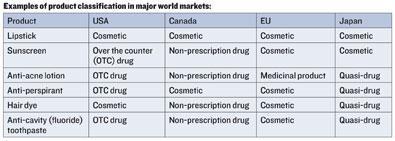
The regulation game
Simply adding more active ingredient can mean that your product turns from being a cosmetic into a tightly-regulated drug, requiring much more stringent, clinical proof of safety and efficacy. ’There is a distinct line between cosmetics and drugs,’ explains Wen Schroeder, president of Seki Cosmeticals in Appleton, Wisconsin. ’In order to be considered a cosmetic a product must only have temporary camouflaging effects. It cannot change the structure or function of the human body.’ This distinction affects what manufacturers are allowed to claim about their products as well as what ingredients they can include, which is why adverts will only ever claim a product to reduce ’the appearance’ of wrinkles rather than the wrinkles themselves.
The term ’cosmeceuticals’, coined in the 1960s, has been used to describe products that are said to have drug-like effects, having bioactivity that goes beyond mere camouflage. ’Many people in the industry want these cosmeceutical products, cosmetics that have an effect on structure and function, to be categorised separately from drugs and cosmetics. It’s one of the most controversial topics in the cosmetic industry,’ says Schroeder.
Mel Elson is a dermatologist from BellSouth Clinic in Texas, US. ’Even though it is not a recognised term, everyone in the industry refers to cosmeceuticals and we all know what they are,’ he says. ’These products are still regulated under the FDA’s 1938 Food, drug and cosmetic act: but they have come a long way since then.’
Complicating things further is the unharmonised global situation for the regulation of drugs. ’The rules are so different in each country. If a company wanted a globally-approved cosmetic, by the time they had met all of the regulatory standards they would end up with a basic emulsion with no active ingredients at all,’ says Schroeder.
Breaking through the barrier
Since regulations tend to minimise the amount of active ingredient in a formulation, it’s important to deliver as much as possible through the outer layer of skin and into the dermis beneath. ’There is an established and well-accepted list of active ingredients that stimulate collagen production,’ says Elson. ’The problem is keeping them stable in a product and getting them to where they are effective. Skin is made to keep stuff out.’

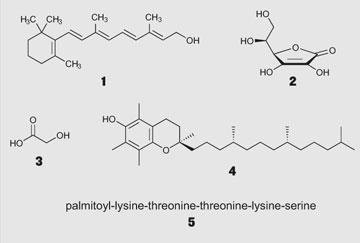
There are two key delivery methods. Microsponges made of porous polymers such as nylon sit on the surface of the skin and slowly release the ingredient, while liposomes offer a more penetrating option. Often used for drug delivery systems, these spherical capsules are able to enclose an aqueous solution within a hydrophobic, phospholipid membrane. They can cross the lipid membranes of cells and penetrate into deeper layers of the skin.
But for those not afraid of needles, there is a far more direct approach to dealing with wrinkles: injectable fillers. The wholesale global dermal fillers market is now estimated to be worth over $450 million (?225 million) in annual sales, an increase of 200 per cent since 2000. (Botox, by far the most popular non-surgical cosmetic treatment, is worth $1 billion globally). According to the American Association of Plastic Surgeons the explosive growth in this market is fuelled by factors including an ageing western population, more disposable income, improved technology, expanding social acceptance and, rather depressingly, increased vanity.

The first injectable wrinkle filler, Zyderm, was made from bovine collagen. It was developed in 1979 by a team at Stanford University in California, US, and once approved by the FDA in 1981, Collagen Corporation and the Beverly Hills collagen injections were born. ’The collagen fibres were extracted from cow hide and enzymatic digestion was used to break down the fibre units,’ explains Dale Devore, vice president of R&D at medical device manufacturer Bioform Medical, based in San Mateo, California, US.
But the fillers were expensive and their effects were only short-lived. On top of this, early products caused allergies. Two to three per cent of people are allergic to bovine proteins, so skin tests needed to be carried out prior to the injections. According to Devore, even these weren’t always effective and some people developed allergies after the test. ’A surgeon I know injected a singer just before she was supposed to accept her Grammy award and, even after the second skin test, she developed a terrible allergic reaction.’ These reactions usually lead to very camera-unfriendly facial swelling.
Zyderm had the monopoly until 1994, when the market was revolutionised by the first hyaluronic acid products. Hyaluronic acid is a polymer of disaccharide units - each made of d-glucuronic acid and d-N-acetylglucosamine - that connects to other extracellular constituents, including collagen, to form a matrix.
It was used in the 1980s as a fluid replacement in osteoarthritis and as a physical cushion in cataract surgery,’ explains Devore. ’A medical company developed it as a replacement for the vitreous liquid in the eye during surgery but it was never used in this way.’ Instead it took off as a dermal filler. Hyaluronic acid itself is broken down very quickly in the skin, so filler developers started to cross-link the polymer, linking chains of hyaluronic acid together or to other molecules such as polyacrylamides, to form longer-lasting gels. A whole range of fillers are now available with a variety of different properties; some even appear to stimulate collagen development.
Fill me up
Miles Graivier, a plastic surgeon with his own practice in Atlanta, US, says that most customers opt for the short-term hyaluronic acid fillers, which have become something of a trustworthy gold standard in the market. Restalyne, one such filler, was formulated in a collaboration between Swedish company Q-Med AB and Arizona, US-based Medics Aesthetics, and was the first hyaluronic acid filler to be produced by bacterial fermentation. ’The shorter-acting fillers are suitable for lip plumping and very unlikely to clump,’ says Gravier.

Bioform Medical’s latest semi-permanent filler, Radiesse, contains the bone mineral calcium hydroxyapatite [Ca10(PO4)6(OH)2 ] in the form of microspheres suspended in a gel carrier. These interlinked spheres form their own scaffold and, rather than stimulating the production of endogenous collagen, the gel replaces it. ’This is good for more pronounced facial contouring, including the facial atrophy induced by HIV,’ says Graivier.
A new kind of permanent filler has also appeared recently on the market. ArteFill, manufactured by San Diego-based Artes Medical and approved by the FDA in October 2006, contains polymethlymethacrylate (PMMA) microspheres suspended in bovine collagen gel. ’Dermal enzymes can’t break down these polymers. They scare me to be honest,’ says Devore, ’as the monomer is toxic, although I’ve been assured that they’re cross-linked to such an extent that no monomer can possibly remain in the filler.’
Many filler developers, including Bioform, are turning to biotechnology to improve their products and Devore believes that this is where the future lies. ’There is lots of opportunity to produce bioactive compositions that directly stimulate fibroblast activity but patients won’t be satisfied unless they see immediate, volumising effects,’ he says.
One US firm, Isolagen, based in Pennsylvania, has developed a therapy using the patient’s own fibroblast cells. The process starts by harvesting a 4 mm-square section of skin from behind the ear, which is then refrigerated and shipped to the company, where millions of new fibroblast cells are cultured using their patented (and hence secret) process. Six to eight weeks later, the filler material is sent back to the patient’s physician. The company claims that each ready-to-inject vial will contain 20 million fibroblasts.
Once injected into the desired area, the cells gradually create a network of collagen. ’The storage permits a patient to have fibroblast cells injected ten years from now that are actually ten years younger - a real injection of youth,’ the company claims. The product is currently in Phase II clinical trials.
So the race is now on to find and patent the best route to stimulating old skin back into youth, says Devore. ’This is on its way to becoming a billion dollar market,’ he predicts. ’Once we establish this, it’ll be bigger than botox.’
Further Reading
1 O H Mills and A M Kligman, Semin. Dermatol., 1982, 1, 245
2 M Rieger, Cosmet. Toiletries, 2007, 122, 55






No comments yet